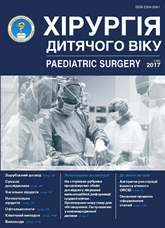Modern approaches to treatment and rehabilitation of children with gastroschisis
DOI:
https://doi.org/10.15574/PS.2017.55.32Keywords:
gastroschisis, newborn children, abdominal wall plastics, visceral-abdominal disproportionAbstract
Objective – to optimize the treatment and rehabilitative measures in children with gastroschisis.
Material and methods. The results of complex treatment and rehabilitation of 76 children with gastroschisis were analyzed. Combined malformations were detected in 43 patients (56.6%). All patients underwent sugery. In newborns with a viscero-abdominal disproportion, grade I, the tight layered closure of abdominal cavity was provided. In the case of visceral-abdominal disproportion, grade II-III, the surgical management of patients was divided into two stages. The first stage included a modified Gross or Z-plastic repair surgery of the anterior abdominal wall with the autodermal patches. The second stage comprised the elimination of the ventral hernia and the plastic reconstruction of the anterior abdominal wall.
Results and discussion. Complications in the postoperative period were mainly septic (peritonitis, destructive pneumonia, purulent meningitis, acute hematogenous osteomyelitis) and occurred in 46 children (60.5%). In 2 patients (2.6%) against the background of the diffuse purulent peritonitis and suppuration of the operating wound in the early postoperative period, there was an event of eventration. The overall mortality rate made up 53.9%. The high mortality rates in newborns with gastroschisis are observed due to septic complications and the presence of combined birth defects that were diagnosed in almost all the deceased. In 10 (28.6%) cases of 35 discharged patients iatrogenic ventral hernia was formed. All patients with ventral hernia during the period of 6 to 9 months from the time of primary surgery (or birth) underwent the Sapezhko plastic reconstraction of the anterior abdominal wall with a good surgical outcomes.
Conclusions. The quality of life of patients with gastroschisis who completed a full course of treatment and rehabilitation and did not have the other birth defects is quite high. Most of these children are fully functioning people of society.
References
Bertsun KT, Bortsun KT. (2007). Taktyka ta periody likuvannia novonarodzhenykh z hastroshyzisom. Visnyk Vinnytskoho derzh med un-tu. 11;1/1: 21–23.
Borova OIe, Zakharus MB, Nykyforuk OM et al. (2009). Hastroshyzis, 10-richnyi dosvid likuvannia. Paediatric Surgery. Ukraine. 6;2: 30–34.
Hrasiukova NI. (2014). Anatomichni osoblyvosti ta stan eventrovanykh orhaniv pry hastroshyzysi u ditei, narodzhenykh shliakhom kesarskoho roztynu. Arkhiv klin medytsyny. 2: 24–25.
Krytskyi IO, Hoshchynskyi PV, Chepesiuk VO. (2014). Likuvalna taktyka ta intensyvna terapiia v dooperatsiinomu ta rannomu pisliaoperatsiinomu periodakh u novonarodzhenykh ditei z hastroshyzysom. Aktualni pytannia pediatrii, akusherstva ta hinekolohii. 2: 54–56.
Krytskyi IO, Hoshchynskyi PV, Voronova TO et al. (2011). Likuvalna taktyka v dooperatsiinomu ta rannomu pisliaoperatsiinomu periodi u ditei z hastroshyzysom. Aktualni pytannia pediatrii, akusherstva ta hinekolohii. 2: 58–60.
Moskalenko VZ, Veselyi SV, Sopov HO, Perunskyi VP. (2003). Likuvannia ta reabilitatsiia ditei z pryrodzhenymy defektamy perednoi cherevnoi stinky. Lvivskyi med chasop. 9; 4: 77–81.
VesYolyiy SV, Grona VN, Perunskiy VP et al. (2006). Metodyi diagnostiki i lecheniya gastroshizisa i omfalotsele u detey. Perinatology and pediatric. Ukraine. 3(27): 137–143.
Moskalenko VZ, Veselyi SV, Sopov HO, Perunskyi VP. (2005). Sposib vyboru khirurhichnoho likuvannia urodzhenykh defektiv perednoi cherevnoi stinky. Deklaratsiinyi patent Ukrainy na korysnu model No. 8668. Zavka No. u200501022 vid 04.02.2005. Opubl. 15.08.2005, biul. No. 8.
Moskalenko VZ, Veselyi SV, Sopov HO, Perunskyi VP. (2004). Sposib shkirno-m’iazovoi plastyky u ditei z urodzhenymy defektamy perednoi cherevnoi stinky. Deklaratsiinyi patent Ukrainy na vynakhid No. 69770 A. Zaiavka No. 20031210921 vid 02.12.2003, opubl. 15.09.2004, biul. No. 9.
Sliepov OK, Gordiyenko IYu, Veselskiy VL et al. (2016). Prenatal diagnosis of gastroschisis in fetuses and newborns. Perinatology and pediatric. Ukraine. 1(65): 73–80.
Sliepov AK, Grasyukova NI, Veselskiy VL. (2014). The results of the «first minutes surgery» in the treatment of gastroschisis. Perinatology and pediatric. Ukraine. 4(60): 18–22.
Sliepov OK, Veselskyi VL, Hrasiukova NI. (2014). Chastota i prychyny smertnosti novonarodzhenykh ditei iz hastroshyzysom. Paediatric Surgery. Ukraine. 3–4: 81–87.
Sliepov OK, Grasyukova NI, Veselskiy VL et al. (2014). Modern problems the diagnosis and treatment of gastroschisis (review). Perinatology and pediatric. Ukraine. 1(57): 26–32.
Sliepov OK, Grasyukova NI, Veselskiy VL et al. (2014). The frequency of intrauterine growth retardation and its impact on the course and prognosis of gastroschisis Perinatology and pediatric. Ukraine. 2(58): 16–20.
Fofanov OD, Hlahovych MV, Fofanov VO et al. (2011). Shliakhy pokrashchennia rezultativ khirurhichnoho likuvannia hastroshyzysu u novonarodzhenykh. Neonatolohiia, khirurhiia ta perynatalna medytsyna. 1; 2: 66–71.
Downloads
Issue
Section
License
The policy of the Journal “PAEDIATRIC SURGERY. UKRAINE” is compatible with the vast majority of funders' of open access and self-archiving policies. The journal provides immediate open access route being convinced that everyone – not only scientists - can benefit from research results, and publishes articles exclusively under open access distribution, with a Creative Commons Attribution-Noncommercial 4.0 international license(СС BY-NC).
Authors transfer the copyright to the Journal “PAEDIATRIC SURGERY.UKRAINE” when the manuscript is accepted for publication. Authors declare that this manuscript has not been published nor is under simultaneous consideration for publication elsewhere. After publication, the articles become freely available on-line to the public.
Readers have the right to use, distribute, and reproduce articles in any medium, provided the articles and the journal are properly cited.
The use of published materials for commercial purposes is strongly prohibited.

